1. Introduction
 EQS is one of the biggest OEM motherboard manufacturers in Hong Kong. With a wide range of solutions for each socket type and excellent user support, EQS Computers appears to have a very bright and promising future ahead of it.
EQS is one of the biggest OEM motherboard manufacturers in Hong Kong. With a wide range of solutions for each socket type and excellent user support, EQS Computers appears to have a very bright and promising future ahead of it.
EQS was among the first to support ATi's solutions for motherboard
chipsets. In the A44P8-MLF model we tested a while ago, EQS used the ATi 9100IGP
and IXP300 chipsets.
With the introduction of ATi's latest chipsets, the Xpress 200G/P
and IXP400, EQS is now releasing a new series of PCI-Express motherboards for
the 939 socket AMD processors. One of these products is the M56K9-MLF that we'll
be reviewing here.
 |
| EQS M56K9-MLF |
Packaging
The M56K9 ships in a standard EQS package, with 2 stickers on it indicating
the motherboard model and the software bundled inside.

Here's a full list of the accessories and software you'll find
inside the package:
Accessories:
1 x Serial ATA cable
1 x Video Out extension for the IGP
2 x USB 2.0 extensions
1 x COM Port module
2 x IDE ATA100/133 cables
1 x IDE ATA66 cable
1 x Motherboard Manual
1 x I/O Metal plate
Software included:
Trend Micro Internet Security
Unfortunately the accessories included in the package might not completely
cover everyone's needs. There's only one Serial ATA cable and not even one SATA
power connector.
2. Features
| Model |
M56K9-MLF |
| Socket |
939 |
| Form Factor |
Micro ATX |
| Northbridge |
ATi Xpress 200G (RS480) |
| Southbridge |
ATi IXP400 |
| Bus Speed (FSB/BSB) |
1000 MHz (2000 MT/s Upstream and Downstream) |
| Hyper Technology |
Hypertransport Technology with one 16-bit link supporting
speeds up to 1GHz (2000MT/s) or 4GB/s in each direction. ATi HyperMemory
Technology |
| Memory |
4 x Dual Channel DDR400 (up to 4GB) |
| IDE Controller |
2 x ATA-133 (UDMA 33/66/100/133) |
| Serial ATA Controller |
4 x SATA-150 (Hardware RAID) |
| RAID Controller |
RAID 0, RAID 1, RAID 0 + 1 (Silicon Image) |
| Floppy Controller |
1 x FDD |
| PCI Slot |
2 |
| PCI EXpress 16X |
PCI Express 16X Slot for graphics card |
| PCI EXpress 1X |
PCI Express 1X Slots for Add-on card |
| VGA |
ATi Radeon X300 PCI Express Technology (9600 core) |
| TV-out |
TV-Out via RCA/S-Video port
NTSC / PAL - Support Dual Display |
| Ethernet |
Realtek 81xx Series 10/100 Mbps LAN |
| USB Port |
8 x USB 2.0 (4 on rear panel and 4 via connector) |
| FireWire |
3 X IEEE1394 FireWire (VIA VT6307) |
| Sound |
5.1 Audio Realtek ALC 55 Chipset |
| System Protection |
Hardware Monitoring with CPU and System Overheat Protection Trend Micro ChipAway BIOS Virus Protection |
| I/O Ports |
1 x D-sub VGA Port
1 x ECP/EPP Parallel port / 1 x Serial Com ports (via cable)
1 x PS/2 Mouse port / 1 x PS/2 Keyboard port
1 x Speaker / 1 x Line-in / 1 x Mic-in ports / 1 x SPDIF Out
1 x RJ-45 / 4 x USB 2.0 |
| Board Size |
244 mm x 244 mm |
MicroATX
The first thing you need to know about the M56K9 is that it's a MicroATX form
factor motherboard. That means that it's smaller than regular ATX motherboards
(24.4x24.4cm against 30.5x24.5cm ) and square in shape. However the board has
no problem and can be easily installed, even in Mid-tower cases.
CPU Socket
The CPU socket follows the standard 939 design. To install the CPU you have
to raise the small lever, plug in the processor and close the lever again. After
that, apply thermal transfer paste on the processor and position the cooling
set on it. The cooler requires no tools to install on the motherboard as you
only have to fasten down another lever so that it hooks on the black plastic
retention mechanism.

Northbridge
The ATi 200G located on the Northbridge is the heart of the EQS M56K9-MLF.
It is the first chipset with an integrated DirectX 9.0 graphics core, but it's
also responsible for some other features on the motherboard such as the AC97
sound, SATA, USB and of course, PCI-Express support.
The graphics core embedded in the 200G is a two pipeline version of the GPU
powering the X300 graphics cards. However, as in all IGP's, in this case too,
the graphics core needs memory to operate.
To solve this problem, ATi utilized its new technology, Hypermemory,
which takes advantage of the bandwidth the PCI-Express bus offers to directly
access physical memory. Through the BIOS, you can choose whether the memory
will be dynamically allocated or a predefined amount of your memory will be
used exclusively by the graphics core.
 |
| No dedicated memory on-board |
Unfortunately, this architecture can cause some loss in performance
as the memory controller will have to operate for both regular system usage
and as a frame buffer to store the image that will be displayed on your screen.
To minimize this loss, the reference board is designed with a small square located
next to the 200G chipset, for an optional memory component to be used as dedicated
frame buffer memory. However, EQS has not equipped the M56K9-MLF with any extra
memory as you can see in the picture above.
Southbridge
The chipset located on the Southbridge of the M56K9-MLK is the ATi IXP400.
A small black heatsink is responsible for its cooling, contributing to the motherboards
fanless design.

Memory Banks
The M56K9-MLF motherboard offers Dual Channel memory support, but unlike other
motherboards, in order to enable it you have to install two same-capacity memories
in slots 1-2, or 3-4 instead of 1-3 and 2-4. Each slot can handle up to 1GB
of physical memory resulting in a maximum memory size of 4GB.
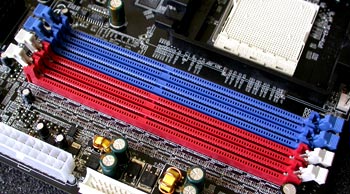
Back Panel
The rear panel input / output provides the following connections, from left
to right and top to bottom:
- the mouse (PS/2) connection
- the keyboard (PS2) connection
- one firewire IEEE 1394a and two USB 2.0 ports
- one parallel connection
- one SPDIF-out and a VGA connection
- one gigabit ethernet lan port and two USB 2.0
- Line In/Line Out/Mic In audio
- Wireless LAN led and Antenna connection

Slots
The EQS M56K9-MLF being a Micro-ATX motherboard, cannot offer as many PCI/PCI-E
slots as regular ATX motherboards. Be it so, there is one PCI-E x16 for a graphics
card, one PCI-E x1 and two more PCI slots for extension cards.

|
| VIA VT6307 FireWire Controller |
|
| ITE IT8712F offering H/W Monitor and Fan Speed Controller |
3. 3DMark03
 3D
Mark is a widely used and accepted benchmark that stresses the DirectX performance
of a VGA card. A very strong point of 3DMark is that its VGA card measuring
does not require any CPU power. So the resulting fps are a good reference of
a VGA card's rendering performance. For testing the performance of each card
we used the 4 game benchmarks 3DMark has.
3D
Mark is a widely used and accepted benchmark that stresses the DirectX performance
of a VGA card. A very strong point of 3DMark is that its VGA card measuring
does not require any CPU power. So the resulting fps are a good reference of
a VGA card's rendering performance. For testing the performance of each card
we used the 4 game benchmarks 3DMark has.
3Dmark03 also includes sound and CPU tests as well as some other feature tests.
- Game Test 1 - Wings of Fury (DX7)

This test is a combat flight simulator written for older hardware (DirectX 7). Particles are used a lot in this test - smoke and vapor trails, flak and gunfire, and explosions are produced using point sprites and quads.
- Game Test 2 - Battle of Proxycon (DX8)

This test is a simulation of first person shooter game types.
1.1 and 1.4 Vertex shaders are widely used since all character models are skinned
using vertex shaders. This makes this test a good vertex shader comparison for
VGA cards.
- Game Test 3 - Trolls' Lair (DX8)

This test should be the favorite of all RPG lovers. It is a cut scene of a female warrior facing two malicious trolls. Again the same vertex and pixel processing is used as in game test 2.
This test also uses post-processing effects, such as Depth
of Field and Bloom effects which are widely used in today's game cut scene sequences.
- Game Test 4 - Mother Nature (DX9)

Mother nature represents the level of effects and realism that are possible using 2.0 vertex and pixel shaders, plus some other features that DirectX 9 offers.
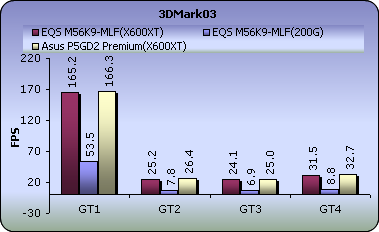
In 3DMark03, we can see that the 200G chipset is outperformed
by a factor of about 3 to 1 by the X600XT we installed on the motherboard. Also,
comparing the X600XT's performance against the two PCI-Express motherboards,
the Asus P5GD2 Premium seemed to provide a little better performance.
- 3DMark Official score
If you test your machine with 3DMark, you can post the results
at 3DMark's online result browser. For more information visit futuremark.com.
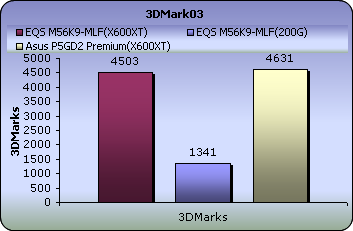
The difference between the X600XT and the on-board integrated
graphics controller is much clearer in the final 3DMarks chart. The EQS M56K9-MLF
cannot take advantage of the X600XT as efficiently as the Asus board does and
falls short by 128 3dmarks behind the latter.
4. Performance Part 2
PCMark04
PCMark04 is an application-based benchmark and a premium tool for measuring overall PC performance. It uses portions of real applications instead of including very large applications or using specifically created code. This allows PCMark04 to be a smaller installation as well as to report very accurate results. You may download a shareware version of PCMark04 from Futuremark.
| |
EQS M56K9-MLF |
PCMarks |
4724 |
File Compression |
3.3 MB/s |
File Encryption |
36.7 MB/s |
File Decompression |
29.0 MB/s |
Image Processing |
14.6 MPixels/s |
Virus Scanning |
2793 MB/s |
Grammar Check |
3.9 KB/s |
File Decryption |
73.6 MB/s |
Audio Conversion |
3157.9 KB/s |
Web Page Rendering |
5.8 Pages/s |
WMV Video Compression |
56.4 FPS |
DivX Video Compression |
69.3 FPS |
Physics Calculation and 3D |
217.6 FPS |
Graphics Memory - 64 lines |
1982.4 FPS |
The older 915P managed to bring the best out of our 3.0GHz Intel processor. WMV Video Compression was the only part of the PCMark04 System Test Suite where it was outperformed by the 925XE of P5AD2-E. All the other tests show significant differences.
3DMark01
You may download a shareware version of 3DMark 2001 from Futuremark.
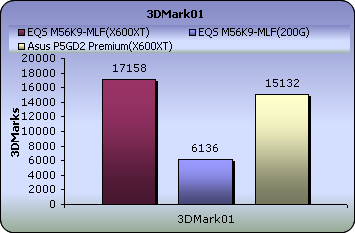
3DMark01 presents us with a great difference between the two X600XT equipped motherboards. However this time the EQS board is the one leading the race.
Aquamark03
Aquamark03 is available for download from Aquamark's
official web site.
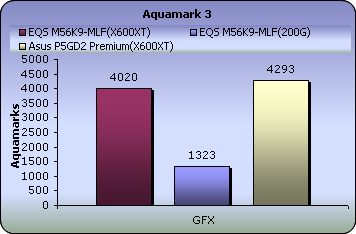
Aquamark03, points once again to the Asus P5GD2 Premium as bringing
the best out of the Powercolor X600XT. The 200G cannot do any better than
1323 in the Aquamark03 GFX score which is one third the performance the external
PCI-Express X600XTs.
5. Half Life 2
Half life 2 is no doubt the most anticipated pc game of
all time. Gamers, having the excellence of Half Life 1 in the back of their
mind as well as the remarkable E3 demo preview, have been anxiously waiting
for the much delayed release of HL2.
Regarding the storyline, the player again picks up the crowbar of research scientist Gordon Freeman, who finds himself on an alien-infested Earth being picked to the bone, its resources depleted, its populace dwindling. Freeman is thrust into the unenviable role of rescuing the world from the wrong he unleashed back at Black Mesa. And a lot of people he cares about are counting on him.



To measure performance, we used the Video Stress Test (VST)
that is available in the CounterStrike:Source beta available through Steam.
We set all the details to the highest level and each time changed the resolution
starting from 800x600 and going up to 1600x1200.
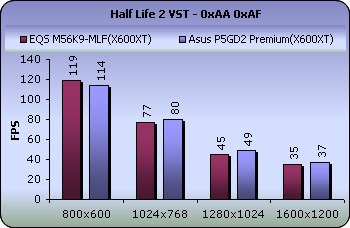
In the Half Life 2 Video Stress Test, the EQS board starts off
at a slightly higher frame rate than the Asus board. However, as we move along
through the higher resolutions, the P5GD2 takes over with a lead of 2-4fps.
6. Ground Control II
 Ground
Control 2 is an action-oriented game of tactics and warfare. As Captain Jacob
Angelus of the Northern Star Alliance, you will command squads of infantry,
artillery, and air power against the might of the Empire of Terra. Base building
and resource-collecting are replaced with unit control and combat tactics where
your knowledge of the battlefield maneuvers will make the difference in your
fight against a ruthless enemy. Position your troops on hilltops for better
aim or inside buildings and forests for protection as you'll need to use every
inch of terrain to your advantage. Call in air strikes or assault pods to bring
the battle behind enemy lines. Send out scouts to locate the enemy and use spotters
for your artillery with the 360° free-roaming camera. Experience the total
immersion of futuristic warfare as you lead your forces to victory!
Ground
Control 2 is an action-oriented game of tactics and warfare. As Captain Jacob
Angelus of the Northern Star Alliance, you will command squads of infantry,
artillery, and air power against the might of the Empire of Terra. Base building
and resource-collecting are replaced with unit control and combat tactics where
your knowledge of the battlefield maneuvers will make the difference in your
fight against a ruthless enemy. Position your troops on hilltops for better
aim or inside buildings and forests for protection as you'll need to use every
inch of terrain to your advantage. Call in air strikes or assault pods to bring
the battle behind enemy lines. Send out scouts to locate the enemy and use spotters
for your artillery with the 360° free-roaming camera. Experience the total
immersion of futuristic warfare as you lead your forces to victory!
For our benchmarks, we used the highest possible settings on the first mission
of the single player game.

Ground Control II offers really impressive graphics without requiring much GPU power. Click on the picture above to view a screenshot from the game. Check out these excellent water effects!
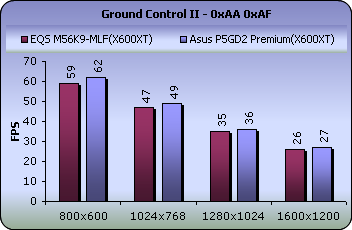
A difference of 1-3fps is once again visible in Ground Control
II. The X600XT seems to generally perform a little better on the Asus board,
even if the EQS is equipped with a much better processor.

7. Bios & Overclocking
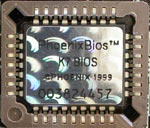
The EQS M56K9-MLF is equipped with a PhoenixBios chipset, providing
all it's BIOS settings and utilities.

One thing to note here is that once again EQS has axed all frequency
and overclocking settings from the BIOS in order to cut down the returns of
damaged motherboards due to badly set clock speeds. The following picture
presents all you get out of Frequency/Voltage Control:

Another section where the board's BIOS differs is the Advanced
Chipset Features screen as seen below. The Internal Video Mode and UMA Frame
Buffer Size are what matter here. The first option can be set to UMA (Unified
Memory Architecture) or Fixed Frame Buffer memory, in other words dynamically
allocated or pre-allocated memory. The second option sets the amount of physical
memory to associate with the graphics core.

As the motherboard features an integrated graphics chipset but
can also operate with a PCI-Express or PCI graphics card, you can choose between
which display will be first initialized and used as the default output.










8. Bundled Software
The included CD-ROM, apart from the drivers, also contains a full version of Trend Micro Internet Security 2004 which is a Firewall-Antivirus hybrid.

However, what's missing from the included CD-ROM is the EQS HardWare
Monitor Version 1.0 that has been recently moved from beta to final. This program
is a tool allowing you to view the CPU temperature, voltage and fan speed through
the Windows environment without having to enter the BIOS.

9. Conclusion
The EQS M56K9-MLF with our AMD 4000+ was outperformed in most
benchmarks by an Intel 3.0GHz-equipped P5GD2 from Asus. However, we shouldn't
forget that this specific motherboard from Asus, is one of the best performers
available on the market and the M56K9's performance was not at all bad compared
to it. Certainly, performance is not something the EQS M56K9-MLF lacks.

Feature-wise, the board's strong points are its MicroATX design
and PCI-E support for AMD processors. This makes it stand out from the rest
of the 939 socket motherboards. When it comes to the bundle and accessories,
you'll find that the package is not very well-equipped. We would like to see
more cables included in the package and maybe some newer software bundle.

Overclocking cannot be performed on this motherboard. Not only
can't you change the voltage or other advanced settings, but you cannot even
set the frequency for your processor.
The motherboard ships at the attractive price of €90.
It's really one of the cheapest boards you can get with a 939 socket and PCI-Express
support. If you don't care much about overclocking and just want to build
a small, convenient box, then the M56k9-MLF is perfect for you.
Pros:
- MicroATX design
- Relatively good performance
- Alternative PCI-E/AMD solution
Cons:
- No frequency/overclocking control
- Incomplete accessories bundle
| Performance |
|
| Features/Bundle |
|
| BIOS/Overclocking |
|
Value for money |
|